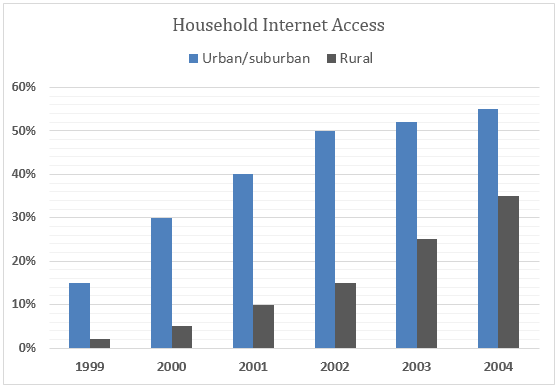IELTS graph 273 - Urban/suburban and rural households that had Internet access
- Details
- Last Updated: Monday, 30 October 2017 20:30
- Written by IELTS Mentor
- Hits: 68320
IELTS Academic Writing Task 1/ Graph Writing - Bar/Column Graph:
You should spend about 20 minutes on this task.
The graph below shows the percentage of urban/suburban and rural households in a European country that had Internet access between 1999 and 2004.
Summarize the information by selecting and reporting the main features, and make comparisons where relevant.
You should write at least 150 words.

Sample Answer:
The bar graph shows the percentages of city and rural households with the internet access in a European country from 1999 to 2004. Generally speaking, fewer percentages of rural households had the internet connection than that of city people and overall internet accessibility enhanced remarkably over the time.
In 1999, merely 2% rural household in this European country had access to the internet while around 15% city dwellers had this facility. Next year, one out of every 20 rural houses gained this access while almost one-third urban and suburban families were connected to the global internet. After two years, half of the city dwellers gained internet access while it was as small as 15% for rural citizens. Next two years, the percentages of households in rural areas who joined this network increased sharply, from 15% to 35%. The ratio of households in urban and suburban areas with the internet access rose to roughly 55%, a slower extension than that of rural households during the last three years. The ratio of homes, both in cities and rural areas, with access to the internet was quite negligible in 1999 but improved dramatically within next 5 years.

Overall, it can be seen that Internet usage in both areas had the tendency to surge throughout the period. Another explicit point is that the city/outskirt households had by far more Internet usage per cent than in the rural areas.
In 1999, the percentage of Internet usage in the urban/suburban area accounted for nearly 15%, while the figure for the rural area took up just a small portion, at which point, both figures doubled in per cent in 2000, the former constituted 30% while the latter accounted for 5% in 2000. In the next year, the percentage of Internet access in the city areas experienced a soar to 40%, while that of rural areas slightly increased to one in ten per cent.
In 2002, it can be witnessed that the proportion of Internet access in the urban/suburban area reached half, while that of the rural area consisted of 15%. In the last year of the survey, the figure for the urban/suburban area slightly aggregated to more than half, while the per cent of Internet access in the rural areas dramatically rocketed to more than one-third per cent (35%).
Report